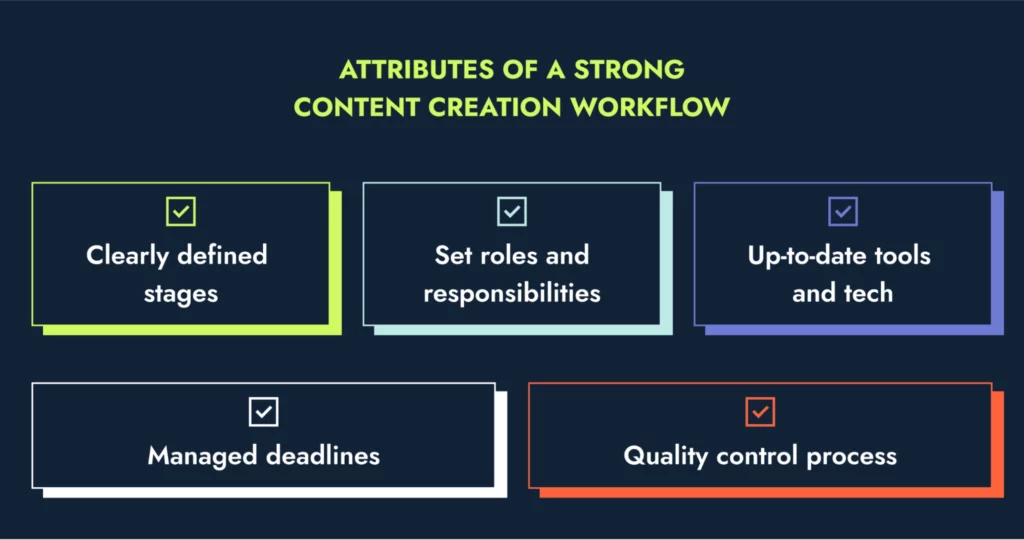A content creation workflow is a meticulously structured and inherently repeatable process that systematically delineates every integral stage required for the comprehensive planning, precise production and eventual publication of content. This systematic methodology is pivotal in ensuring consistency, superior quality and maximal operational efficiency across all emergent content formats and contributing team members.
Having a documented content creation workflow is essential for any marketing team that wants to produce high-quality output at scale.
Content workflow explained
A content workflow is the sequence of steps required to create and distribute content. It serves as a process roadmap, helping content marketing teams complete tasks in the right order and within set deadlines. Without a content workflow, production can feel disorganized, rushed or inconsistent — especially when multiple contributors are involved.
In the absence of a clearly articulated content workflow, the content production process is prone to manifesting as disorganized, excessively rushed or fundamentally inconsistent, especially in scenarios involving a multiplicity of collaborative contributors within SEO writing endeavors.
Why content workflows are important
A content workflow helps convert strategy into structured, repeatable execution. It provides teams with a predictable process that supports alignment between content production and business outcomes. This alignment ensures content is created and delivered consistently, with minimal disruption. According to the Adobe Trust Report, 72% of users state that receiving timely content increases their level of trust in a brand.
Having a well-managed content workflow process also improves visibility and tracking. Each stage can be monitored for bottlenecks or delays, helping teams refine their systems and optimize output. These improvements lead to stronger content performance, better collaboration and increased alignment with marketing KPIs.
⭐️ Want to ensure your content creation process supports rankings and revenue? Read our B2B SEO strategy guide.
Key attributes of a content creation workflow
An effective content creation workflow should include the following attributes:
- Clearly defined stages: Content audit, ideation, planning, writing, review and publishing
- Assigned roles and responsibilities: Ownership for each step in the process
- Workflow management tools: Platforms to track, automate and monitor
- Timelines and deadlines: Enforced schedules to maintain momentum
- Quality control gates: Built-in reviews for brand, grammar, tone and accuracy
This structure is the engine behind a functional content calendar. A good workflow adapts to different content types, scales with your team and reduces confusion across departments. Shared docs, real-time feedback and recurring check-ins help prevent misalignment. According to Content Marketing Institute, 42% of ineffective strategies have misaligned goals and focus.
The presence of robust workflows significantly augments collaborative synergy. For example, copywriting and design teams can collaborate to produce cohesive content assets.
Steps of a content production workflow
Content production is where content comes to life. This part of the workflow focuses on execution — writing, designing, editing and publishing the final deliverable.
Stages in the content production process include:
- Writing: Drafting content to match tone, voice and intent
- Design: Adding visuals such as images, charts or video
- Editing: Reviewing content for clarity, grammar and flow
- Formatting: Structuring content for the chosen platform
Each step requires different skills, but the outcome must feel unified. A well-run content marketing workflow ensures that final assets are accurate, brand-aligned and visually polished.
Benefits of content workflow software
Content workflow software plays a vital role in managing and optimizing the writing process. These tools offer features such as task management, collaboration and automation, making it easier for teams to work together efficiently.
Using specialized content marketing workflow software can help you save time with:
- Centralized workspaces: One location for assets, notes and timelines
- Task automation: Auto-assigning, scheduling and publishing pieces of content
- Team collaboration: Built-in comments, notifications and approvals
- Workflow visibility: Clear status updates for all content in progress
- Performance analytics: Insights into what’s working and what’s not
The right software can transform a content workflow from a series of individual tasks into a coordinated, streamlined operation. By providing a centralized platform for all content-related activities, these tools enhance transparency, reduce errors and improve overall productivity.
✍️ Want to create content that actually converts? Explore our proven B2B SaaS content writing process.
Best practices for content creation workflows
By implementing a well-defined workflow, companies can improve their content marketing efforts and achieve their business goals.
Here are some best practices:
- Create a straightforward process and ensure your content team is well-trained on it. According to Gartner, only 41% of B2B marketers have a well-documented process in place.
- Regularly review and update the workflow to ensure it remains effective and aligned with current marketing trends and technologies.
- Establish clear communication channels and feedback loops to facilitate collaboration among team members.
- Use data and analytics to track the performance of your content and identify areas for improvement in your workflow.
- Incorporate flexibility into your workflow to accommodate different types of content and unexpected changes or challenges.
Optimize your content workflow management
When properly built, your content marketing strategy should do more than fill a calendar — it should drive pipeline. From target audience and keyword research to writing, Productive Shop helps B2B SaaS teams create high-impact editorial calendars that support every stage of the buyer journey.
Looking to turn your content ops into a growth engine? Contact our team today and see how we can help you plan, write, design and distribute assets that actually convert.









